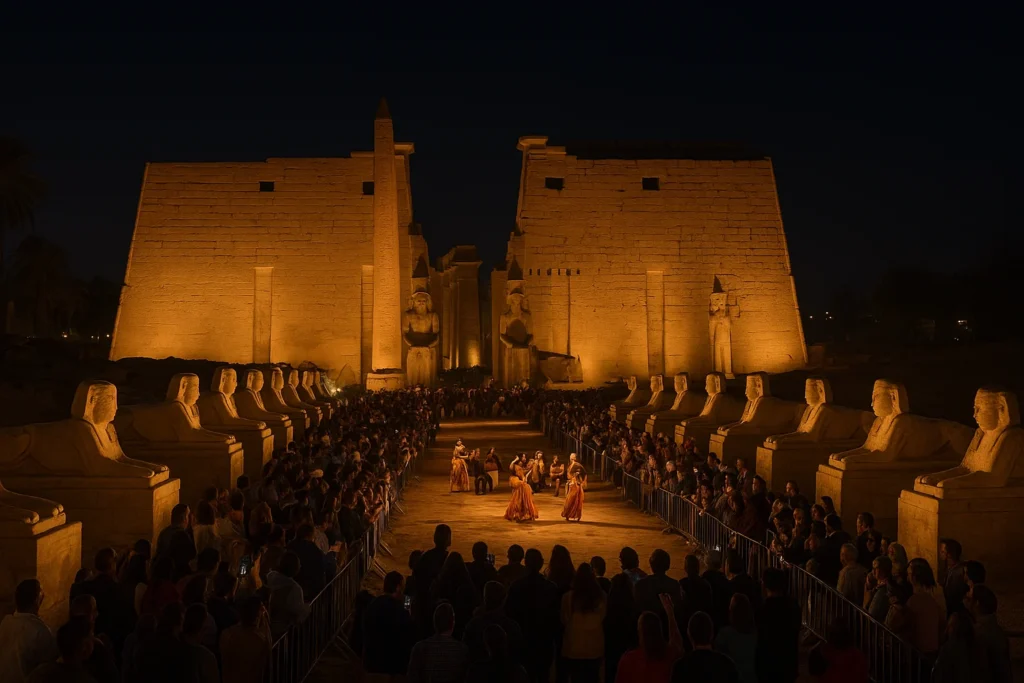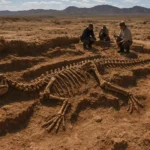Dawn of a New Era: The Grand Reopening Ceremony
The air over Luxor, that ancient city built upon the foundations of Thebes, was heavy with a profound sense of anticipation. As the sun dipped below the horizon, casting its final golden rays across the Nile, a palpable hush fell over the gathered dignitaries, archaeologists, and local residents. The scent of lotus blossoms and myrrh, intentionally scattered along the ancient pathway, mingled with the dry desert air. Then, in a moment that would be etched into the annals of history, a single torch flared to life near the colossal First Pylon of Luxor Temple. Its flame danced in the twilight, a beacon of a past long forgotten. Then another, and another, until the entire 2.7-kilometer stretch of the Avenue of Sphinxes blazed with a resplendent light, revealing row upon row of majestic statues standing sentinel after centuries of obscurity.
What followed was a theatrical spectacle designed not just for entertainment, but for historical fidelity. Hundreds of performers, their costumes meticulously recreated from ancient tomb paintings, brought the Opet Festival to life. The deep, resonant tones of ceremonial drums echoed off the sandstone columns, a rhythm that had once guided the steps of pharaohs. Modern-day Egyptians, with solemn reverence, carried replica sacred barques along the exact route their ancestors had walked over three millennia ago. The ceremony reached a crescendo as a powerful beam of light, originating from Karnak Temple, pierced the night sky and connected directly with the Luxor Temple. This symbolic gesture was a modern reenactment of the ancient avenue’s primary purpose: to physically and spiritually unite these two great religious centers.
Standing before the illuminated colossi of Ramses II, President Abdel Fattah el-Sisi declared, with immense pride, that this was “not just the reopening of an ancient road, but the rebirth of Egypt’s living memory.” His words resonated deeply, for this project had been a monumental undertaking, requiring the relocation of entire neighborhoods, the painstaking restoration of over a thousand sphinx statues, and decades of relentless archaeological work. Now complete, the Avenue of Sphinxes stood as a testament to Egypt’s enduring commitment to preserving its unparalleled heritage and sharing it once more with the world.
The Sacred Pathway Through Time: A Narrative of Power and Devotion
Origins in the New Kingdom: The Blueprint of a Divine Thoroughfare
The Avenue of Sphinxes, also known as the “Rams Road,” traces its formal origins to the golden age of the New Kingdom. While a processional way likely existed in some form even earlier, it was during the magnificent reign of Pharaoh Amenhotep III (1386–1349 BCE), one of Egypt’s most prolific builders, that the avenue was formalized into the monumental thoroughfare we see today. His vision was a testament to his dynasty’s power and devotion.
Archaeological evidence and inscriptions reveal the extraordinary scale of this project. The original construction involved:
- An estimated 1,350 sphinx statues placed approximately six meters apart, a dense guard of divine protectors.
- A paved roadway, meticulously crafted and up to 76 meters wide in some sections, wide enough for the grandest of processions.
- Intricate decorative gateways and waystations at regular intervals, providing points of rest and ritual.
- A sophisticated system of drainage to protect the avenue from the annual floodwaters of the Nile, a marvel of ancient civil engineering.
The avenue was a physical representation of the theological connection between the great temples, a sacred corridor of power that was the beating heart of Thebes.
The Opet Festival: A Spectacle of Divine Union
The avenue’s primary purpose was to facilitate the annual Opet Festival, arguably the most important religious celebration in ancient Egypt. For nearly two weeks each year, coinciding with the Nile’s inundation season, the sacred statues of the Theban Triad—Amun, Mut, and Khonsu—would travel from their home in Karnak to “visit” Luxor Temple. This was no ordinary parade; it was a symbolic journey, a cosmic ritual reenacting the very foundations of Egyptian belief.
This grand procession represented three core tenets of their faith:
- The Divine Marriage: It symbolized the mystical union between the god Amun and the pharaoh’s divine ka, or life-force, thereby ensuring the prosperity of the land and the legitimacy of the ruler.
- The Creation Cycle: The journey mirrored the gods’ own passage through the cosmos, representing the continuous cycle of creation, death, and rebirth.
- Royal Legitimization: By participating in the festival, the pharaoh reinforced his divine right to rule in the eyes of his people and the gods themselves, cementing his place as the earthly embodiment of Horus.
Contemporary accounts describe a spectacle of unimaginable splendor. Priests carried gilded barques, some weighing over a ton, on their shoulders. Dancers and musicians performed along the route, filling the air with the sounds of sistrums and the fragrance of incense. Thousands of citizens, from nobles to commoners, lined the path for a chance to glimpse the sacred statues and receive their blessings.
Later Additions and Modifications: A Palimpsest of Rulers
The avenue saw significant expansions and modifications under a succession of rulers, each adding their own mark. The boy king Tutankhamun famously repaired damage that had been inflicted during the tumultuous Amarna period. But it was under Nectanebo I of the 30th Dynasty that the avenue saw one of its most significant revitalizations. He added many new sphinxes, and it is his face that graces many of the human-headed statues that stand closest to Luxor Temple.
Remarkably, the avenue remained in use for nearly 1,500 years before gradually falling into disrepair during the Roman era. As Christianity spread, many sphinxes were deliberately defaced or toppled, their pagan symbolism a target. Others simply succumbed to the relentless march of time and the encroaching desert sands, which slowly entombed them in a vast, silent burial.
The Modern Rediscovery: Archaeology Against All Odds
Early Excavations and the Whispers of a Lost Path
The avenue’s modern story began in 1949 when Egyptian archaeologist Zakaria Ghoneim, working near the Luxor Temple, made a startling discovery: the first twelve sphinxes. His initial excavations confirmed the existence of a paved surface and revealed fragmentary inscriptions naming Amenhotep III. These finds were an electrifying hint of a much larger, buried reality. However, political instability and a lack of funding meant that progress was slow and fitful for decades. By the 1970s, only about 200 meters of the avenue had been properly excavated, a tantalizing but incomplete glimpse of the whole.
The Turning Point: A Visionary Plan Comes to Life
In 2005, a new and ambitious plan was launched under the direction of Dr. Zahi Hawass, then Secretary-General of the Supreme Council of Antiquities. His vision was to fully uncover and restore the entire avenue, a project many considered to be a pipe dream. The challenges were immense and multi-faceted.
1. Urban Clearance and Community Diplomacy: The most difficult and sensitive aspect was the need to clear a modern city to unearth an ancient one. This required the relocation of over 3,000 residents and the demolition of more than 500 modern buildings. In a testament to thoughtful planning, the 13th-century Abu Haggag Mosque, a historical treasure in its own right, was preserved through innovative engineering that allowed the ancient sphinxes beneath it to be excavated without disturbing the structure above. This process became a model for community-involved archaeology, with the government providing compensation and new housing to the affected families.
2. Archaeological and Conservation Efforts: The physical work was a painstaking process that lasted over two decades. It involved:
- Meticulous excavation of the full 2.7 km length of the pathway.
- The careful documentation of over 1,050 unearthed sphinx statues, each a unique piece of a colossal puzzle.
- The use of modern technology like laser scanning and 3D modeling to create digital archives of the statues and help reconstruct missing fragments.
- A profound commitment to conservation, using traditional materials like a specific type of mortar to repair the sandstone statues, ensuring that the repairs were both durable and historically authentic.
The project employed hundreds of local workers, providing them with training and a sense of shared ownership in their heritage. By 2021, the team had achieved what many thought impossible: the complete restoration of this ancient wonder.
A Walk Through History: Experiencing the Avenue Today
Starting at Karnak: The Ram-Headed Guardians
For visitors today, a walk along the avenue is a journey through time. Beginning at the northern terminus at Karnak Temple, one is greeted by the magnificent ram-headed sphinxes. These crio-sphinxes, representing the god Amun in his protective aspect, stand in dignified silence. The original 30th Dynasty bases and the hieroglyphic inscriptions detailing Nectanebo I’s contributions can still be seen. The walk begins at the ceremonial gateway where the sacred processions once started their epic journey.
The Middle Sections: A Tapestry of Ages
As you walk south, the avenue reveals layers of its history. Here, you can see evidence of later additions, such as the Roman-era kiosk where processions paused. The excavation pits, left visible for educational purposes, expose the original paved layers of the road, showing how different eras built upon the foundations of the last. Look closely and you might even discover ancient worker’s graffiti, simple markings left by the builders, a poignant and deeply human connection to the past.
Approaching Luxor Temple: The Human-Faced Sphinxes
The final stretch of the avenue is the most dramatic. The ram-headed sphinxes give way to the iconic human-headed sphinxes, many of which bear the likeness of Nectanebo I. Here, the statues are often the best-preserved, and some still show faint traces of original paint fragments, a vibrant hint of how colorful this path once was. The walk culminates in a breathtaking approach to Luxor’s First Pylon, a finale that leaves an indelible impression on anyone who has made this journey.
Controversies and the Delicate Balance of Preservation
The Relocation Debate
The project was not without its critics. The massive urban clearance, while essential for the restoration, was a contentious issue. The displacement of long-time residents and the demolition of some Ottoman-era buildings raised questions about the ethics of prioritizing ancient history over modern communities. While the government provided compensation, the debate over changing the urban fabric of Luxor continues to be a crucial part of the avenue’s modern story.
Restoration Philosophy
Some scholars also raised concerns about the restoration itself. They debated whether too many sphinxes were reconstructed rather than left in their found state, arguing that this practice might obscure ancient damage patterns and shift the balance from pure conservation to a more tourism-focused reconstruction. This ongoing dialogue highlights the complex and often difficult choices archaeologists and preservationists must make.
The Future: Luxor as a Living Museum
With the avenue’s completion, a new era for Luxor has begun. Egypt plans to hold annual Opet Festival reenactments, complete with the stunning costumes and musical performances from the grand reopening. The avenue will also be the stage for nightly sound and light shows, offering visitors a magical experience. Furthermore, plans include the development of virtual reality reconstructions to allow guests to experience the avenue as it would have appeared in antiquity, fully colored and bustling with life. Extended excavations are also planned to uncover the full three-kilometer length of the original path, a testament to the belief that Luxor’s story is still being written.
Epilogue: Echoes of Eternity
Standing on the restored Avenue of Sphinxes at dusk, as the stones release the day’s heat and the first stars appear above Luxor Temple, one can almost hear the distant echoes of sistrums and chanting priests. This is more than an archaeological site; it is a bridge across time, a tangible connection to the world of the pharaohs. The Avenue of Sphinxes is a magnificent living monument, a place where history is not just read about, but profoundly felt. As the ancient Egyptians themselves might have said: “To walk this path is to walk with eternity.”



